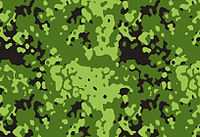M84 camouflage pattern

The M/84 Pletsløring (“spot camouflage”) pattern is a derivative of the Flecktarn B pattern produced by the German firm Marquardt & Schulz. Using the same shapes and pattern, the number of colours was changed from 5 to 3 – choosing olive green, light green and black to better match the colouration of the Danish woodland environment. The use of spots creates a "dithering" effect, which eliminates hard boundaries between the different colors in much the same way the squares in the newest digital camouflage patterns do. The pattern is designed for use in temperate woodland terrain. It has been adapted as desert camouflage by varying the colors. It is to be replaced by M/11.[1]
History
In 1978 the Danish government developed a camouflage pattern, to be trialled as replacements for the solid olive-grey "moleskin" combat uniform. The T/78 was never adopted but it eventually evolved into the M/84 pattern. The M/84 pattern was introduced in 1984, hence the name (Model 1984). In 2001 the M/01 was introduced, a dessert variant, for the fighting in Afghanistan. It was announced in 2012 that the army would replace the current camouflage patterns with MultiCam, dubbed M/11.[2]
Modern Use
While the M/84 is being replaced by the M/11, it is a slow process and still widely used by the Danish Armed Forces. It is also very sought after by collectors and enthusiast, due to the quality and rarity. Furthermore both an Urban and Snow version have been produced for commercial use.[3]
Other users

Variants
-
 Trail version T/78
Trail version T/78 -
 M/84
M/84 -
 T/96
T/96 -
 Urban
Urban -
 Snow
Snow
External links
| Wikimedia Commons has media related to M84 camouflage pattern. |
References
- ↑ "First Official Look at the New Danish Uniform". Krigeren (in Danish). Retrieved 27 February 2015.
- ↑ "First Official Look at the New Danish Uniform". Krigeren (in Danish). Retrieved 27 February 2015.
- ↑ "Danish M/84 "Pletsløring" camouflage pattern". STRIKE - HOLD!. Retrieved 24 February 2015.
